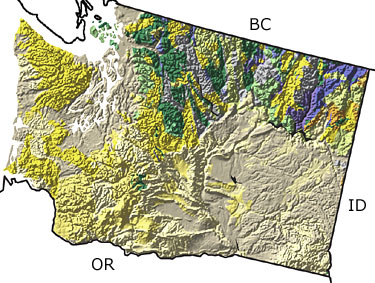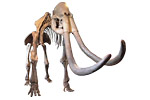

Washington, US |
|||||||||||||||||||||||||||||||||||||||||||||||||||||||||||||||
|
|||||||||||||||||||||||||||||||||||||||||||||||||||||||||||||||
Paleontology and geologyThe Precambrian: Precambrian rocks exist only along the northeastern portion of the state. Since the Precambrian, huge amounts of crust have been added to the western edge of the North American continent. All the land west of the Precambrian rocks has been created through complex tectonic processes along an active continental margin or transported from elsewhere and accreted onto the continent of this region. Paleozoic: In the early Paleozoic, easternmost Washington was at the edge of a large ocean. Early Paleozoic fossiliferous sandstone, shales, and limestone were deposited along this ancient shoreline. Other Paleozoic sedimentary rocks of Washington were transported as exotic terranes and accreted to the margin of the continent in the Mesozoic. These terranes contain unrelated slivers of Devonian-, Carboniferous-, and Permian-aged rocks, originally formed far from their present location. Mesozoic: During the late Jurassic and early Cretaceous, numerous blocks of exotic terranes were added to the western edge of the North American continent to form most of what we know as Washington state today. British Columbia and Oregon are also made up primarily of these terranes. Most of these terranes consist of narrow, banded,rock sequences, often overturned and formed far from their current location ómuch like a badly shuffled deck of cards. They include volcanic island rocks and fossiliferous marine sediments that originated elsewhere in the Pacific Ocean. Jurassic and Cretaceous fossils occur in the north-central and northwestern part of the state. By the end of the Mesozoic, approximately two-thirds of the state was assembled. Cenozoic: Cenozoic marine sediments make up the western part of Washington and were formed as the sea gradually retreated westwards. Marine fossiliferous sandstones and siltstone cover most of Washington west of the Cascades Mountains. The Olympic Mountains consist of marine sedimentary rocks uplifted about 10 million years ago. The Cascade volcanic began in the mid-Cenozoic and has been active ever since. Continental sedimentary rocks are not common. Continental ice sheets covered the northern third of the state during the late Cenozoic, and alpine glaciers covered the Cascades and Olympic Mountains. Large and small mammals lived at the edge of the ice, and salmon swam up the rivers to ice-blocked dams. |
|||||||||||||||||||||||||||||||||||||||||||||||||||||||||||||||
Links to more on Washington paleontology |
|||||||||||||||||||||||||||||||||||||||||||||||||||||||||||||||
|
Collecting and Legalities | Careers | Organizations Collecting and LegalitiesCareers Organizations
|
|||||||||||||||||||||||||||||||||||||||||||||||||||||||||||||||
|
site tour |
about the site |
site map |
site credits |
page credits |
help |
FAQs |
contact |
||

